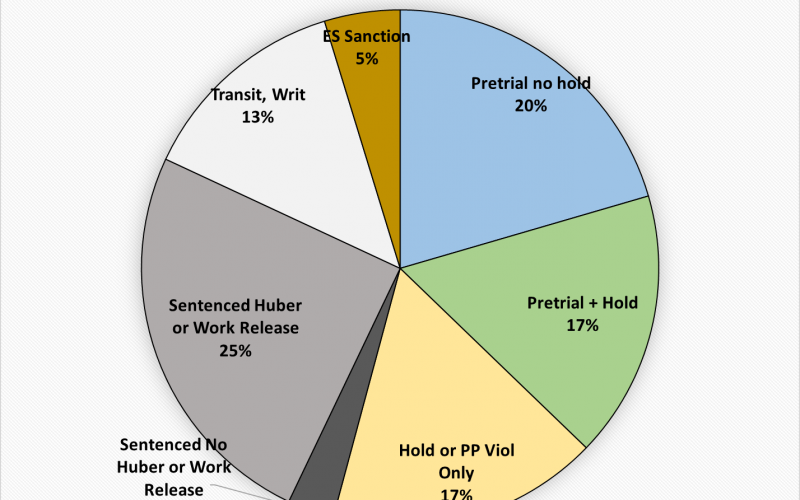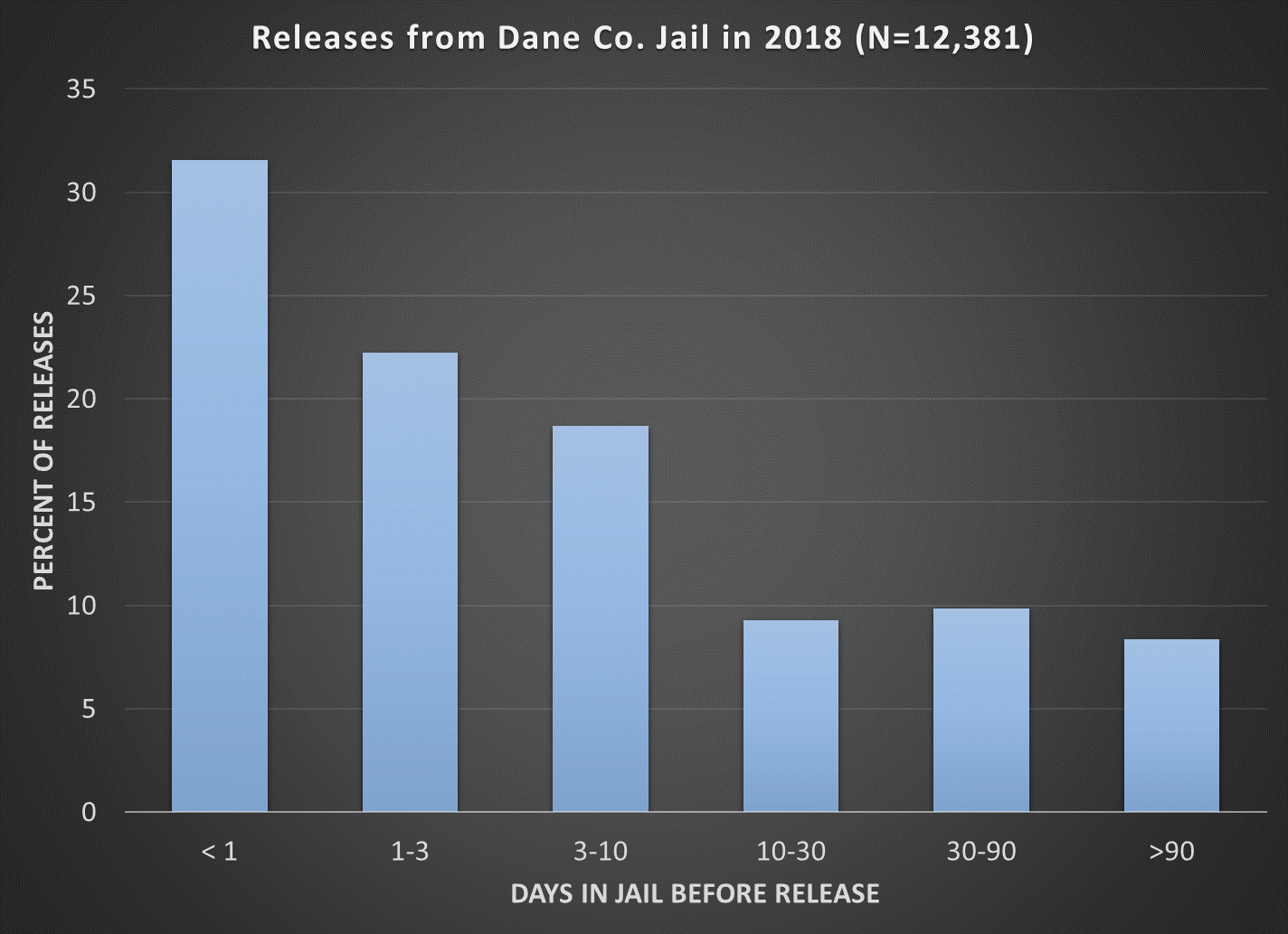December 2019
This report is my summary of the August 2019 “Analysis of the Dane County Jail Population” written by James Austin, Roger Ocker, and Wendy Naro-Ware of the JFA Institute (note1). The JFA report concludes that the best way to reduce the jail population is to speed the processing of cases of people held in pretrial detention or on probation/parole holds and to shorten the length of jail sentences by a third to a half. I don’t dispute their conclusions, but hope to contribute to discussions by presenting their data in somewhat different format and calling attention to the people impacted by even short jail stays. A PDF version of this blog post is linked here.
The JFA report first summarizes general statistics that show that Dane County is below the national average in jail incarceration, crime, and arrests per crime and that the jail population was stable 2010-2016. Then it summarizes of its own analysis of data from two samples: (1) a snapshot of the 825 people in jail on April 25, 2019 and (2) the 12,383 releases from jail in 2018. Having determined that biggest contributors to the jail population are the lengths of stay for people ultimately released as “sentence completed” and “transfer to another agency,” they randomly sampled 35 cases in those categories and paid special attention to the time spent in pretrial detention and the time taken to resolve probation parole holds. They conclude that the most effective way to reduce the jail population is to speed up case processing by 7-14 days. They also say that jail sentences could be reduced by a third (from an average of 180 to an average of 120 days), citing research that longer jail sentences have little effect on reoffending.
I turned some of their numbers into graphs to help illustrate the issues.
Time in Jail Before Release
The first chart shows the days to release for 12,381 releases from the Dane County jail in 2018. (Two had un//known time to release.) The second chart shows the same information as a cumulative plot. About a third of the people released from jail have been in less than a day. These are mostly people who can quickly post cash bail from the bail schedule for misdemeanors (see note 2), with amounts ranging from $30 to $10,000 depending on the offense. Another 22% are released within 1-3 days; these would mostly be people released after arraignment, either by paying a cash bail or fine or being released on a signature bond or own recognizance. Over half of the people who enter jail leave very quickly. Then there are people who stay longer: 19% stay 3-10 days and 9% stay 10-30 days. These relatively short stays are still long enough to be disruptive of child care and jobs and create crises in people’s lives. Ten percent are in jail 30-90 days and 8% more than 90 days. The long jail stays contribute more to the number of beds occupied in the jail than the short jail stays.
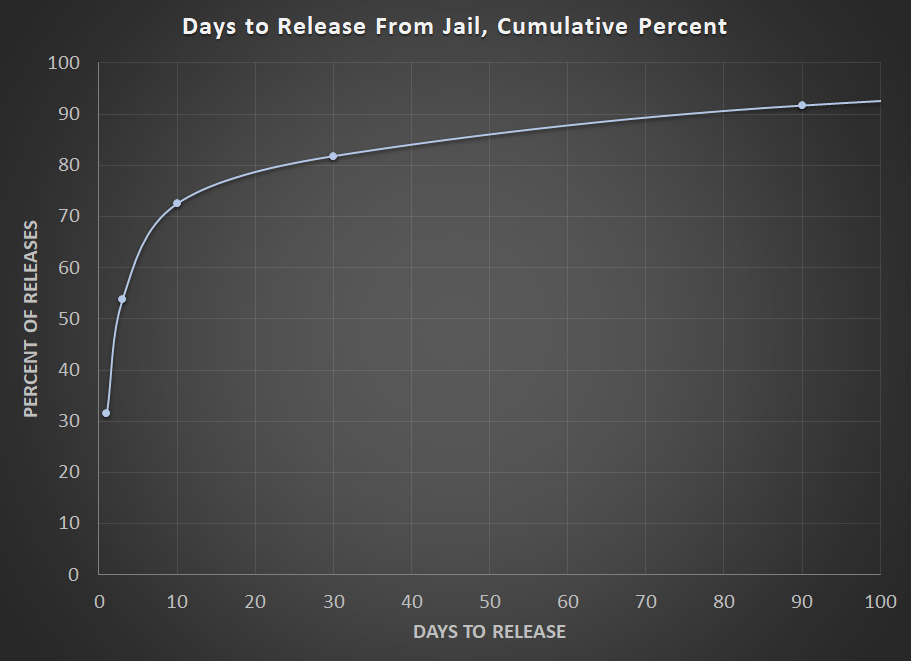
Status of Those in Jail
I grouped the categories from the jail report to highlight the main patterns (see note 3 for details). In the snapshot of the 825 people who were in jail on one day in 2019, a quarter were serving sentences with Huber or work release privileges and were generally housed at the Ferris Center on Rimrock Road, not in the downtown jail.
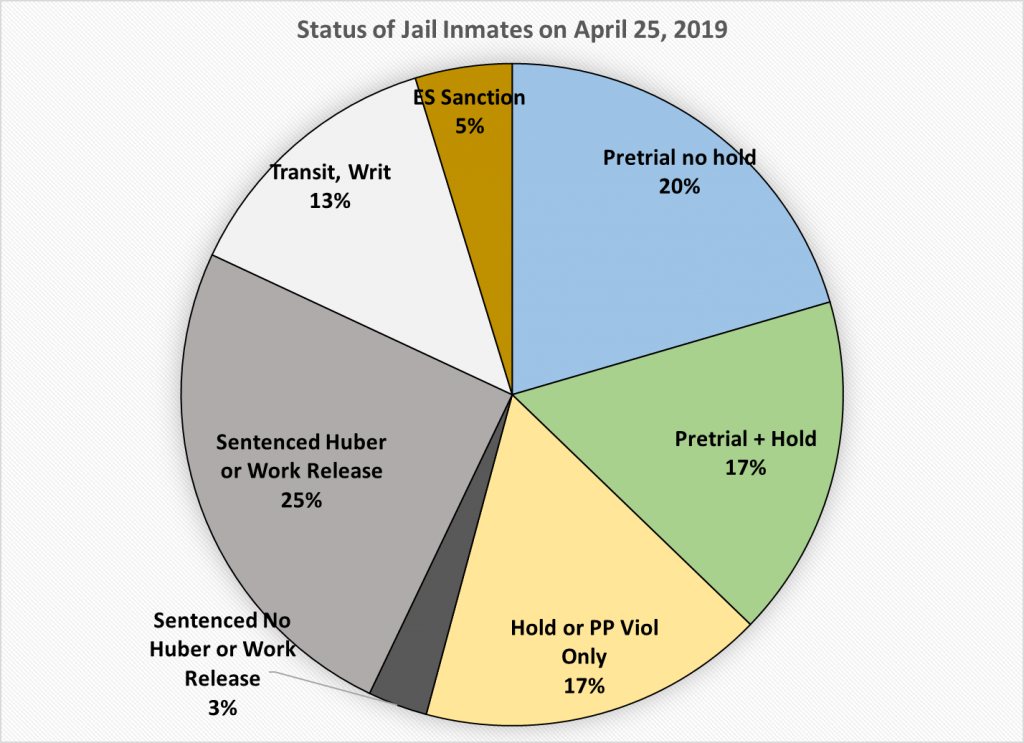
A fifth of the jail inmates were in pretrial detention: they had either been denied bail or have a bail higher than they can afford to pay, or perhaps have chosen to remain incarcerated pretrial. Another 17% are in jail on a “hold” from the Department of Corrections: they are on probation or extended supervision and are being detained because they have violated a condition of supervision and are being considered for revocation. These “holds” are controlled by the Department of Corrections, not by Dane County. Some holds are at the discretion of the probation/parole officer while others are required. For example, if someone on supervision is accused of threatening violence, there is a mandatory hold while that accusation is investigated. It is common that when someone on supervision is accused of a crime, a “hold” is also placed on them, so there are another 17% who are in custody with a status that is both pretrial and on hold. Someone accused of a crime may be revoked to prison before being found guilty of the new crime, and some people are revoked even though they are found not guilty of the new crime. Among those who are serving a jail sentence, the large majority have Huber or work release privileges. This means that they are out of the jail during the day but must return to jail in the evening. Most of these are housed at the Ferris Center on Rimrock Road, not in the jail downtown. About 13% of jail inmates are being held for other jurisdictions (in transit, writ) and 5% are being held on an extended supervision sanction, which is controlled by the Department of Corrections.
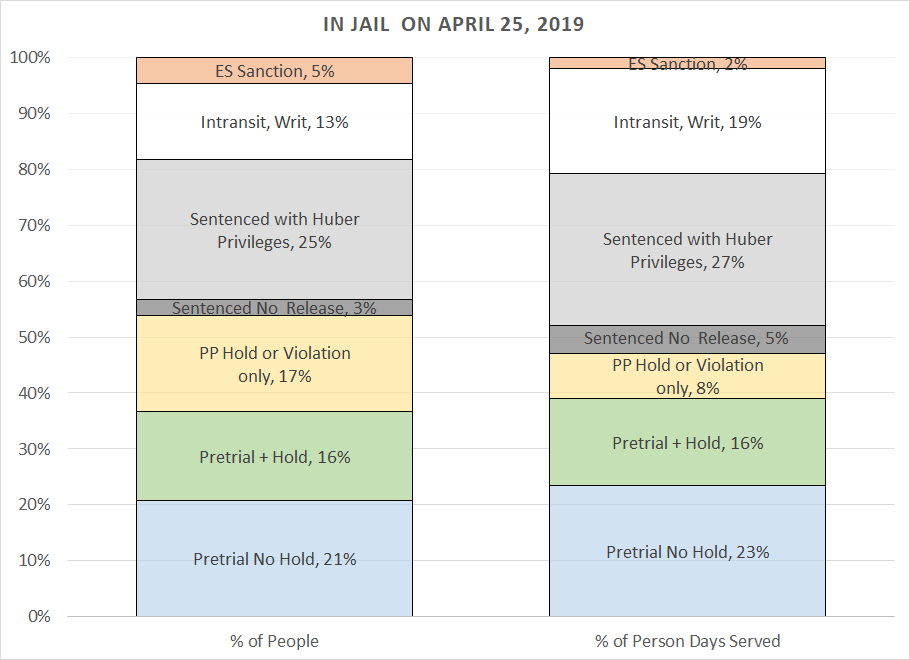
Looking at length of stay as well as number of people, the JFA report gives the average length of stay to date for everyone who was in jail on the snapshot day and we may multiply that average by the number of people in the category to calculate the person-days in jail for each category. For the snapshot of one day, the percent of people and percent of elapsed person-days are fairly similar, with the big difference being that probation/parole holds are a smaller percentage of the person-days and the people who are in transit to another jurisdiction account for a higher proportion of person-days.
Status at Release
The JFA categorization of people’s status at jail release is different from the categorization in the snapshot. It tells you who was released after completing a sentence but not whether they were in the jail before sentencing, and it combines transfers to prison after sentencing with transfers to prison for a violation of supervision. The percentage of all releases is the status at release of the 12,383 releases. The “estimated person-days in jail” is calculated by multiplying the average length of stay at release by the number of people in the release category. These percentages are very different.
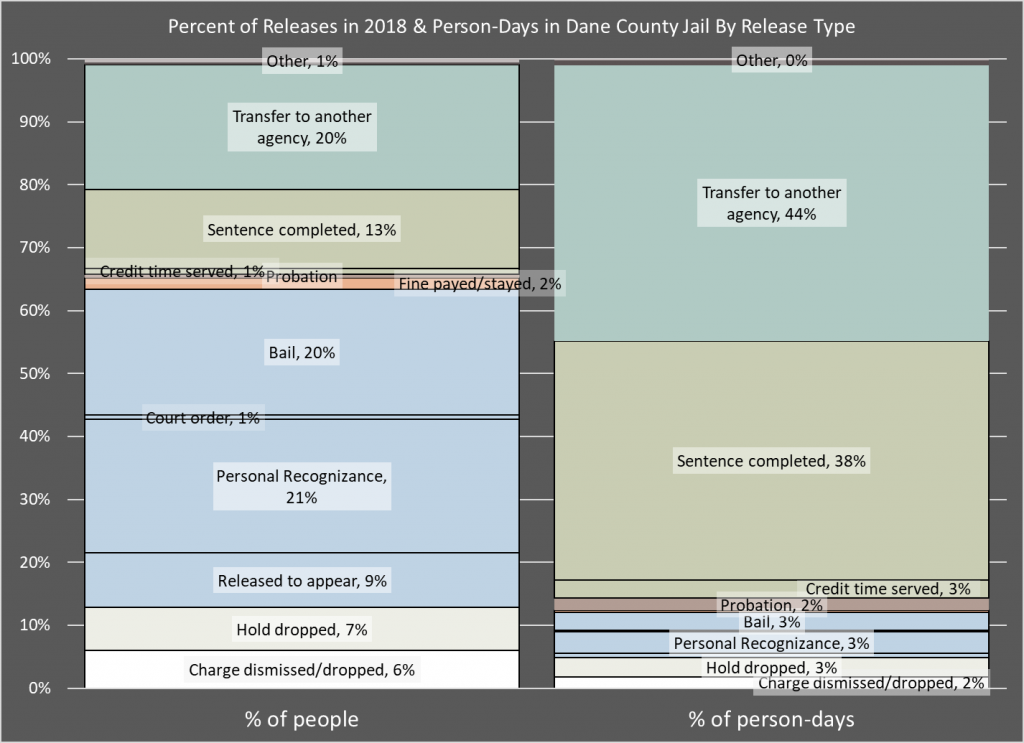
The JFA report focuses on the very large percentage of days before release in the “transfer” and “sentence completed” categories. However, the experience of spending some time in jail is important as well, even if the stay is relatively short. Six percent of the people who are released from jail have had their charges dismissed or dropped, and they have served an average of 7 days in jail at the time of release. Although this is only 2% of the person-days in the jail, these are people who are ultimately not convicted who spent enough time in jail to have their lives disrupted. Seven days in jail can lead to job loss, disruption of child care, and loss of a home. Similarly, 7% of the releases and 3% of the person days involve a probation/parole hold that is ultimately dropped; their average stay is 10 days. Even though these are a small part of the jail population, they represent a significant justice issue.
Just over half, 51%, of jail releases are pretrial, including released to appear, personal recognizance, bail, and a court order, while only 6% of the person-days in jail is for people released pretrial. Most people who are released pretrial are released rapidly, even though a large share of the people in jail are in pretrial status, so people released from pretrial status account for a small percentage of the person-days in jail. Most of the people who spend a long time in pretrial status end up leaving either “after sentencing” (they serve time pretrial and then more time after sentencing) or as a “transfer” to prison. Similarly, most people who spend a long time in “hold” status end up as transfers to prison.
Pretrial Detention and Bail
We need information not in the JFA report. We need to separate people by intake categories to understand what happens to people who are arrested and not quickly released on bail or a signature bond. Who is remaining in jail longer than three days without a probation/parole hold? How many are being kept in jail by a high cash bail? How many who get out of jail in three to thirty days do so by pleading guilty quickly? How many people who are really not guilty are languishing in jail awaiting adjudication?
There is a growing debate about the unfairness of systems of cash bail, where low income defendants sit in jail while high income defendants get out even when charged with serious crimes. Dane County Judge Nicholas McNamara studied bail in Dane County and reported that signature bonds requiring no money were issued in 81% of all cases, including 97% of criminal traffic cases, 86% of misdemeanor cases and 69% of felonies (see note 4). A 2018 report by Wiscontext.org (see note 5) found that 9% of the 889 inmates in jail on July 20, 2018 were being held on cash bail. That is, they could have bailed out if they had paid the cash. In July 2018, fourteen people were being held on $200-$500, nineteen on $600-$1500, 18 on $2000-$6000, nine on $7000-$15,000, ten on $16,000-$50,000 and thirteen on $100,000 or more. Of the 32 who had bail greater than $10,000, most were being held for serious violent crimes, although one was being held for fleeing police. Of those being held on bail of $500 or less, most had a prior failure to appear and/or open cases and prior convictions.
Notice that this 9% in July 2018 held for cash bail is less than half of the 20% who were being held pretrial without a hold in April 2019. It is unclear whether bail was denied for the other half, whether July 2018 and April 2019 had very different jail populations, or whether there are other reasons for pretrial detention.
We know from Judge McNamara’s report last year (note 4) that 75% of all criminal cases end in a guilty plea, 23% are dismissed, and only 1% go to trial. A defendant’s position in the plea-bargaining process is much better if they are not in jail during the process: if you are detailed pretrial, essentially the only way to get out is to plead guilty. We want to know the proportions of cases that end in guilty pleas versus dismissal by the detention status. The 6% released from jail by dismissal or charges dropped is much lower than the 23% Judge McNamara cites, suggesting that those who are not in jail have a higher rate if dismissal. My own analysis of 2004 Dane County court records suggested that detention at the time of sentencing made a big difference in a guilty plea versus dismissal. Similarly, the ability to hold out and demand a trial rather than a plea bargain is dependent upon not being incarcerated before the trial. A 2017 study published in the Stanford Law Review by Paul Heaton, Sandra Mayson and Megan Stevenson that argues that pretrial detention for even a few days both increases guilty pleas and increases the risk of future crime (see note 6).
According to a detailed and very informative report by Emily Hamer and Sheila Cohen of the Wisconsin Center for Investigative Journalism published on the Wisconsin Public Radio web site, Wisconsin is well below the national average in the use of cash bail but still has issues. This article again reviews the harmful consequences of pretrial detention, especially for people who are not guilty of what they are accused of.
Additional Issues
The JFA report was focused on how to most efficiently reduce the jail population and its answer were: (1) speed pretrial processing; (2) speed decisions about revocations; and (3) reduce jail sentence lengths. These recommendations assume that everyone in jail should be there and the only issue is speeding up the processing.
There are additional important questions that we would like answered from more detailed analysis. This would require access to the underlying data. The report also gives us the age, race, and offense breakouts of the jail population, but it is hard to interpret that information without knowing more about how these intertwine with people’s status at admission and release and their length of stay. We can say that a jail population that is 46% Black when the population of Dane County is only 5.5% Black represents an obvious disparity. But we would want to know much more about rates of pretrial detention, bail, length of stay, charges.
We are told that people with mental illness issues are a large part of the jail population, but we have no indication what the status of mentally ill people in the jail is. Pretrial? On a hold? Serving a sentence?
What are the charges for the people who are in the combined pretrial/hold status? How many of them have holds for crimes that would not normally result in prison time? How many of these holds are discretionary? Do these holds get dropped prior to adjudication? How many people end up getting revoked to prison from this pretrial/hold status?
For those people who end up transferred to another facility, is it correct to infer that this is generally a prison? What proportion of people go from pretrial detention to prison? What proportion go from a probation/parole hold to prison? We note that only a small percentage of releases are in the category “hold dropped,” which suggests that many of those holds result in a transfer to prison.
The Department of Corrections controls probation/parole holds. Even though Dane County does not control these holds, it can aid public debate by providing information about the charges for people in the combined pretrial/hold category and about the length of holds and the proportion of holds that result in revocation to prison.
Are jail sentences the right length? We don’t want to reduce the jail population by increasing the prison population, and we appreciate the JFA recommendation that says that shorter jail sentences are likely to be just as effective (or ineffective) as longer ones in reducing recidivism. But we might also press for more information about probation instead of jail time. Finally, to assess our system for fairness, we would like to track the race/ethnicity of jail inmates to understand whether the length of pretrial detention is correlated with race/ethnicity or other factors.
Notes
- The JFA report is available on the Dane County Criminal Justice Council site https://cjc.countyofdane.com/documents/Analysis-of-the-Dane-County-Jail-Population-JFA-Institute.pdf . The report also available from Madison.com at https://madison.com/jfa-institute-analysis-of-dane-county-jail/pdf_873c14fe-bfe7-5cfa-a587-e66f5eb04615.html
- Wisconsin schedule of bonds and fees specifies the bail for a long list of misdemeanors. https://wicourts.gov/publications/fees/docs/bondsched18.pdf
- For the April 25 2019 snapshot, I have grouped the categories from the report. (1) Pretrial no hold includes status “none,” CO Pre-arraignment, CO Pretrial, Presentence Investigation (2) Pretrial + hold includes CO Pre-arraignment/Hold, CO Pre-arraignment/Probation, CO Pretrial/Hold, CO Pretrial/Prob Hold, and Presentence Invest/Hold; (3) Hold or PP Violation Only includes P/P Violation (Hold) and P/P Viol/Outside Hold. (4) Sentenced No Huber or Work Release includes Sentenced W/O Huger, Sentenced W/O Huber/PO hold, Sentenced Huber Revoked, Prob Sentence/No Work Release, Prob Sent/Work Rel Revoked, Sentenced/Outside Hold (5) Sentenced Huber or Work Release includes Sentenced with Huber Privileges, Prob Sentence/Work Release, Sentenced/Outside Hold – Huber. People on Huber or Work Release are out during the day but must return to the jail in the evening. (6) Transit, Writ includes people being held temporarily for another agency including State Prisoner Writ, State Prisoner Intransit, Federal Prisoner Intransit; (7) E.S. Sanction includes all those on extended supervision sanction, most of whom do not have work release.
- A copy of Judge Nicholas McNamara’s report is posted here: https://university.pretrial.org/HigherLogic/System/DownloadDocumentFile.ashx?DocumentFileKey=7c5831b1-a6c2-11f3-b439-2e76f50ffe0d&forceDialog=0
- News coverage by Capital Times: https://madison.com/ct/news/local/govt-and-politics/judge-s-report-majority-of-defendants-in-dane-county-criminal/article_5c102d55-92ce-5b92-9f95-a987cb7b682e.html
- News coverage by Wisconsin State Journal: https://madison.com/wsj/news/local/courts/most-defendants-in-dane-county-criminal-cases-released-without-cash/article_4a64c5ae-ed1f-5383-b504-c990f61f915a.html
- Report by Wiscontext.org about bail in Wisconsin. https://wiscontext.org/rippling-effects-and-inequities-cash-bail-wisconsin
- A 2017 Stanford Law Review Study by Paul Heaton, Sandra Mayson and Megan Stevenson that argues that pretrial detention for even a few days both increases guilty pleas and increases the risk of future crime. https://review.law.stanford.edu/wp-content/uploads/sites/3/2017/02/69-Stan-L-Rev-711.pdf
- Emily Hamer and Sheila Cohen of the Wisconsin Center for Investigative Journalism, “Poor Stay in Jail While Rich Go Free: Rethinking Cash Bail in Wisconsin” published on the Wisconsin Public Radio site https://www.wpr.org/poor-stay-jail-while-rich-go-free-rethinking-cash-bail-wisconsin This article gives extensive information about the bail issue and explains that Wisconsin has a below-average rate of pretrial detention.

